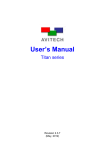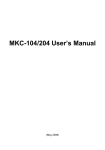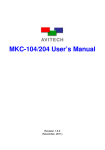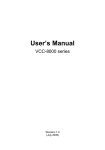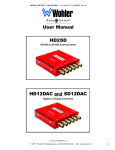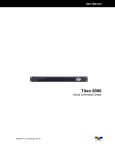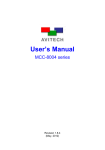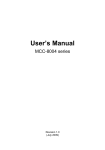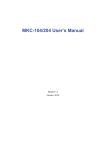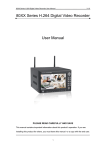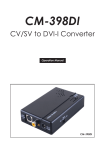Download Manual
Transcript
User Manual Titan 8000 Visual Command Center Revision 2.3.8, (March, 2014) User Manual ABOUT THIS MANUAL This manual contains information on how to use Avitech Titan 8000. Throughout the manual the following conventions are used to distinguish elements of text. provides additional hints or information that requires special attention. identifies warnings which must be strictly followed. Any name of a menu, command, icon or button displayed on the screen is shown in a bold typeset. For example: On the Start menu select Settings. To assist us in making improvements to this user manual, we would welcome any comments and constructive criticism. Email us at: [email protected]. WARNING Do not attempt to disassemble Titan 8000. Doing so may void the warranty. There are no serviceable parts inside. Please refer all servicing to qualified personnel. TRADEMARKS All brand and product names are trademarks or registered trademarks of their respective companies. COPYRIGHT The information in this manual is subject to change without prior notice. No part of this document may be reproduced or transmitted in any form or by any means, electronic or mechanical for any purpose, without the express written permission of Avitech International Corporation. Avitech International Corporation may have patents, patent applications, trademarks, copyrights or other intellectual property rights covering the subject matter in this document. Except as expressly written by Avitech International Corporation, the furnishing of this document does not provide any license to patents, trademarks, copyrights or other intellectual property of Avitech International Corporation or any of its affiliates. TECHNICAL SUPPORT For any questions regarding the information provided in this guide, call our technical support help line at 425-885-3863, or our toll free help line at 1-877-AVI-TECH, or email us also at [email protected] ii Contents About This Manual .................................................................................................................... ii Technical Support ..................................................................................................................... ii Warranty.................................................................................................................................... iv Limitation of Liability ............................................................................................................... iv Extended Warranty Options.................................................................................................... iv Services and Repairs Outside the Warranty Period ............................................................. iv Regulatory Information ........................................................................................................... iv Federal Communications Commission (FCC) Statement .................................................... iv European Union CE Marking and Compliance Notices ....................................................... iv Australia and New Zealand C-Tick Marking and Compliance Notice ................................. iv 1. Getting Started ............................................................................................................ 1 1.1 Package Contents .............................................................................................................. 1 1.2 Product Features ............................................................................................................... 3 1.3 Specifications .................................................................................................................... 4 1.4 Connections to the Titan 8000 ......................................................................................... 5 2. Hardware Configuration .............................................................................................. 6 2.1 Cascading ........................................................................................................................... 9 2.1.1 Cascading 2 or More Titan 8000 ........................................................................ 10 2.1.2 Cascading Titan 8000 With MCC 8004 ............................................................... 13 Appendix A Simplified Control Panel (SCP) ............................................................... 17 A.1 Using the Simplified Control Panel ................................................................................ 17 A.2 Preparing Titan for Use With SCP Keypad.................................................................... 18 A.3 Recalling Presets ............................................................................................................. 19 Appendix B Resetting to the Factory-Default State (Clearing the Flash Memory) ... 21 Method 1 .................................................................................................................................. 21 Method 2 .................................................................................................................................. 21 iii Warranty Regulatory Information Avitech International Corporation (herein after referred to as “Avitech”) warrants to the original purchaser of the products manufactured in its facility (the “Product”), that these products will be free from defects in material and workmanship for a period of 1 year or 15 months from the date of shipment of the Product to the purchaser. There is a 3 month grace period between shipping and installation. Marking labels located on the exterior of the device indicate the regulations that the model complies with. Please check the marking labels on the device and refer to the corresponding statements in this chapter. Some notices apply to specific models only. Federal Communications Commission (FCC) Statement This equipment has been tested and found to comply with the limits for a Class A digital device, pursuant to Part 15 of the FCC Rules. These limits are designed to provide reasonable protection against harmful interference when the equipment is operated in a commercial environment. This equipment generates, uses, and can radiate radio frequency energy and, if not installed and used in accordance with the instruction manual, may cause harmful interference to radio communications. Operation of this equipment in a residential area is likely to cause harmful interference, in which case the user will be required to correct the interference at his own expense. Properly shielded and grounded cables and connectors must be used in order to meet FCC emission limits. Avitech is not responsible for any radio or television interference caused by using other than recommended cables and connectors or by unauthorized changes or modifications to this equipment. Unauthorized changes or modifications could void the user's authority to operate the equipment. Operation is subject to the following two conditions: (1) this device may not cause harmful interference, and (2) this device must accept any interference received, including interference that may cause undesired operation. If the Product proves to be defective during the 1 year warranty period, the purchaser’s exclusive remedy and Avitech’s sole obligation under this warranty is expressly limited, at Avitech’s sole option, to: (a) repairing the defective Product without charge for parts and labor; or (b) providing a replacement in exchange for the defective Product; or (c) if after a reasonable time is unable to correct the defect or provide a replacement Product in good working order, then the purchaser shall be entitled to recover damages subject to the limitation of liability set forth below. Limitation of Liability Avitech’s liability under this warranty shall not exceed the purchase price paid for the defective product. In no event shall Avitech be liable for any incidental, special, or consequential damages, including without limitation, loss of profits for any breach of this warranty. If Avitech replaces the defective Product with a replacement Product as provided under the terms of this Warranty, in no event will the term of the warranty on the replacement Product exceed the number of months remaining on the warranty covering the defective Product. Equipment manufactured by other suppliers and supplied by Avitech carries the respective manufacturer’s warranty. Avitech assumes no warranty responsibility either expressed or implied for equipment manufactured by others and supplied by Avitech. European Union CE Marking and Compliance Notices Statements of Compliance English This product follows the provisions of the European Directive 1999/5/EC. Dansk (Danish) This Warranty is in lieu of all other warranties expressed or implied, including without limitation, any implied warranty of merchantability or fitness for a particular purpose, all of which are expressly disclaimed. Dette produkt er i overensstemmelse med det europæiske direktiv 1999/5/EC. Nederlands (Dutch) Dit product is in navolging van de bepalingen van Europees Directief 1999/5/EC. This Hardware Warranty shall not apply to any defect, failure, or damage: (a) caused by improper use of the Product or inadequate maintenance and care of the Product; (b) resulting from attempts by other than Avitech representatives to install, repair, or service the Product; (c) caused by installation of the Product in a hostile operating environment or connection of the Product to incompatible equipment; or (d) caused by the modification of the Product or integration with other products when the effect of such modification or integration increases the time or difficulties of servicing the Product. Suomi (Finnish) Tämä tuote noudattaa EU-direktiivin 1999/5/EC määräyksiä. Français (French) Ce produit est conforme aux exigences de la Directive Européenne 1999/5/EC. Deutsch (German) Dieses Produkt entspricht den Bestimmungen der Europäischen Richtlinie 1999/5/EC. Any Product which fails under conditions other than those specifically covered by the Hardware Warranty, will be repaired at the price of parts and labor in effect at the time of repair. Such repairs are warranted for a period of 90 days from date of reshipment to customer. Ελληνικά (Greek) To προϊόν αυτό πληροί τις προβλέψεις της Ευρωπαϊκής Οδηγίας 1999/5/EC. Íslenska (Icelandic) Þessi vara stenst reglugerð Evrópska Efnahags Bandalagsins númer 1999/5/EC. Extended Warranty Options Avitech offers OPTIONAL Extended Warranty plans that provide continuous coverage for the Product after the expiration of the Warranty Period. Contact an Avitech sales representative for details on the options that are available for the Avitech equipment. Italiano (Italian) Questo prodotto è conforme alla Direttiva Europea 1999/5/EC. Norsk (Norwegian) Dette produktet er i henhold til bestemmelsene i det europeiske direktivet 1999/5/EC. Services and Repairs Outside the Warranty Period Avitech makes its best offer to repair a product that is outside the warranty period, provided the product has not reached its end of life (EOL). The minimum charge for such repair excluding shipping and handling is $200 (US dollars). Português (Portuguese) Este produto cumpre com as normas da Diretiva Européia 1999/5/EC. Español (Spanish) Este producto cumple con las normas del Directivo Europeo 1999/5/EC. AVITECH INTERNATIONAL CORPORATION ● 15377 NE 90th Street, Redmond, WA 98052 USA ● TOLL FREE 1 877 AVITECH ● PHONE 1 425 885 3863 ● FAX 1 425 885 4726 ● [email protected] ● http://avitechvideo.com Svenska (Swedish) Denna produkt har tillverkats i enlighet med EG-direktiv 1999/5/EC. Australia and New Zealand C-Tick Marking and Compliance Notice Statement of Compliance This product complies with Australia and New Zealand's standards for radio interference. iv 1. Getting Started This chapter introduces the features and specifications as well as external components of Titan 8000. It also guides you through the process of setting up your Titan 8000. 1.1 Package Contents After unpacking the shipping carton, the following items can be found: Avitech Titan 8000 Utility Disc (software and user manual) Redundant DC Power Supply (optional) * Standard Power Cord (USA customer only) 14-inch RS-485 Cascading Cable (optional – 16-inch DVI-I Cascading Cable (optional – D when purchasing 2 or more Titan 8000) when purchasing 2 or more Titan 8000) 1 RJ-50 GPIO / Tally Terminal Block D DVI-I Male to Female Cable (optional) ** DVI-I Breakout Cable (optional) D DVI to VGA Adapter (optional) Avitech Phoenix TACP (optional) *** D Avitech MKC (optional) *** Ear with screw (already installed on Titan 8000 upon order for D assembly on to rack mount) Table 1-1 Package Contents 2 * This is an optional external power supply along with associated dual power supply PCBA inside Titan 8000 to achieve power redundancy. If this optional external power supply is connected, power (AC or DC) can be unplugged on Titan 8000 without affecting power supply to unit. ** When using DVI-I female connector on Titan 8000, connector may easily be damaged if DVI-I plug (male) has bended pins. With this optional DVI-I male to female cable permanently connected to Titan 8000, then frequent connection and disconnection will only occur to female end of this short cable, rather than to female connector of Titan 8000. *** Avitech Phoenix TACP and MKC can be used with Titan 8000. Contact your authorized dealer or refer to Phoenix TACP or MKC User Manual for more details. 1.2 Product Features Table 1-2 Titan 8000 Series Video Comparison Automatic sensing of HD/SD-SDI and NTSC/PAL analog input Automatic detection of optimal display resolution Computer graphic input: single scalable DVI-I input (VGA/DVI/NTSC/PAL) resolution up to 1920×1200 (WUXGA), any position Up to 26 internal configuration presets On-screen display (OSD) of labels, borders, and video alarms Standalone operation (single Titan) with communication control via IP or RS-232; or multiple operations One Titan can fit in a single rack unit (RU) space for a maximum of 8 video inputs and one multimedia input Compatibility with Phoenix-G (formerly Galaxy) software for configuration, monitor layout, and multiple-system control Avitech ASCII Protocol (AAP) support HDCP-compliant RJ-50 GPI terminal block adapter for tally or loading presets Up to 26 presets/configurations can be saved and recalled from module’s Flash EEPROM Compatible with MCC 8004 modules (non-HDCP compliant Titan only) Supports Avitech MKC 104/204 (mouse/keyboard controller) 3 1.3 Specifications Input SDI/CVBS (BNC connector) DVI-I GPI (terminal block adapter) Automatic sensing HD-SDI: 1080i59.94, 1080i60, 1080i50, 720p59.94, 720p60, 720p50 SD-SDI: 525p59.94, 625p50 NTSC/525i / PAL/625i Number of inputs Titan 8002V: 2 automatic detection VGA/DVI (YPbPr) Titan 8004V: 4 automatic detection VGA/DVI (YPbPr) Titan 8004C: total is 4 2 automatic detection VGA/DVI (YPbPr) 480p60, 720p50/60, 1080i50/60, 576p50, plus 2 automatic detection PAL/NTSC Titan 8008C: total is 8 4 automatic detection VGA/DVI (YPbPr) 480p60, 720p50/60, 1080i50/60, 576p50, plus 4 automatic detection PAL/NTSC Titan 8004U: total is 4 2 automatic detection VGA/DVI (YPbPr) 480p60, 720p50/60, 1080i50/60, 576p50, plus 2 automatic detection HD/SD-SDI/ PAL/NTSC Titan 8008U: total is 8 4 automatic detection VGA/DVI (YPbPr) 480p60, 720p50/60, 1080i50/60, 576p50, plus 4 automatic detection HD/SD-SDI/ PAL/NTSC Automatic sensing, input can be used as background or to cascade with another Titan 8000; supported input signal: Up to 1920×1200 (WUXGA) Number of input: 1 8; configurable for tally or loading preset Output Number of output: 1 800×600 up to 1920×1200 (WUXGA) Note: No simultaneous DVI and RGB output is possible when Titan model supports HDCP. DVI-I Others RS-232 RJ-45 RS-485 Housing Power Dimension/Weight Environment/Safety Baud rate: up to 1 Mbaud Network Type: 100Base-T Number of ports: 2 Metal Power consumption is less than 30W Power Supply: 100 ~ 250 V AC / 50/60 Hz (external) Dimension, 483×254 mm (19×10 inch) – 1RU Weight, 3.6 kg (8 lb) Temperature: Operating: 0 C (32 F) to 40 C (104 F) Storage: –10 C (14 F) to 50 C (122 F) Humidity, 0% to 80% relative, non-condensing Safety, FCC/CE/C-Tick/Class A Table 1-2 Specifications 4 1.4 Connections to the Titan 8000 Figure 1-1 Titan 8000 Components Front Panel Indicator Lights green when Titan 8000 is powered on Table 1-3 Titan 8000 Front Component Description Rear Panel DVI / VGA In Dip Switches Serial Serial Power (AC) Cascade In DVI Out SDI In GP Input Ethernet (IP) ID RS-485 In/Out Power (DC 12V) DVI-I connector for DVI (YPbPr) VGA video input sources Updates the firmware (left); as well as reset Titan 8000 to factory-default setting Keypad connector for signal from optional Avitech MKC (Mouse Keyboard Controller) or numerical Simplified Control Panel (SCP) keypad RS-232 connector for signal from computer Connects to 100 to 240 V AC power cord DVI-I connector for multimedia input (cascade from other Titan 8000 or from other video source as background image) DVI-I connector for output to monitor BNC connectors for HD SD-SDI NTSC PAL video input sources RJ-50 connector for general purpose input For setup via Avitech Phoenix-G utility through network connection Rotary dial to assign unique addresses in systems with two or more chassis For serial cascading input/output Connects to the 12 V DC power adapter Table 1-4 Titan 8000 Rear Component Description 5 2. Hardware Configuration Perform the following steps to get your Titan 8000 series up and running: The steps outlined next would depend on type of configuration you wish to set up. Step 1. Option 1 (module without HDCP function) Connect up to 4 BNC cables to 4 Video 1 / 2 / 3 / 4 ports for: – HD/SD-SDI / NTSC/PAL video inputs or; – NTSC/PAL video inputs. Or Connect up to 4 VGA/DVI cables to 4 Computer/YPbPr 1 / 2 / 3 / 4 ports for VGA/DVI video inputs. Option 2 (module with HDCP function) Connect up to 4 BNC cables to 4 Video 1 / 2 / 3 / 4 ports for: – HD/SD-SDI / NTSC/PAL video inputs or; – NTSC/PAL video inputs. Or ® Connect up to 4 DVI/HDMI cables to 4 Computer/YPbPr 1 / 2 / 3 / 4 ports for DVI/HDMI video inputs. OR Figure 2-1 Connect Up to Four Video Sources 6 Step 2. Connect RS-232 cable to RS-232 port for signal from computer. And/or, connect Ethernet cable to IP port for using computer’s Phoenix-G (formerly Galaxy) software to perform setup on the Titan. Figure 2-2 Connect RS-232 / Ethernet Signal from Computer Step 3. Connect DVI-I cable to DVI-I Cascade port for video input to the Titan. Figure 2-3 Connect DVI-I Cable to DVI-I Cascade Port 1. 2. 3. Make sure that resolution of input source (as background image) is the same as resolution of DVI-I OUTPUT port for video output to monitor. When connecting to computer with NVIDIA™ display card use DVI-to-VGA adapter that came with NVIDIA™ display card instead of the included Avitech DVI-to-VGA adapter. HDCP-compliant content is not supported for DVI-I Cascade port of Titan. 7 Step 4. Option 1 (module without HDCP function): Connect DVI/VGA cable to DVI-I Output port for video output to monitor (you may need to use a DVI-to-VGA adapter for monitor with VGA input). Option 2 (module with HDCP function): Connect DVI/HDMI cable to DVI-I Output port for video output to monitor (you may need to use a DVI-to-HDMI adapter for monitor with HDMI input). OR Figure 2-4 Connect to Output Monitor 1. 2. To display HDCP-compliant content, make sure that monitor is also HDCP-compliant. Display of HDCP-compliant content is not possible when using a DVI-VGA Y-cable. 8 Step 5. Make sure to assign a unique address to your Titan ID rotary dial when connecting to systems with two or more units. Figure 2-5 Assign Unique Address to Titan ID Rotary Dial Step 6. Connect AC power cord to 100~250V power jack. Figure 2-6 Connect the AC Power Cord Connect optional 12 V DC power adapter if available to achieve power redundancy. Power (AC or DC) can then be unplugged without affecting power supply to module. 2.1 Cascading Cascading is the technique of “daisy-chaining” 2 or more Titan 8000 modules through a DVI display and a digital control backbone. This connection allows combined modules to operate as a single integrated system. Up to 8 different modules can be combined in this fashion to create extremely large and complex systems with ability to simultaneously monitor audio, video, and computer signals on same display. If a module should fail, then control and video information is passed through to allow continued operation of system. 9 2.1.1 Cascading 2 or More Titan 8000 When cascading multiple Titans with and without HDCP function, make sure to connect Titan(s) with HDCP function together in sequence and Titan(s) without HDCP function connected together in sequence. Titan with HDCP function must be the last module that connects to monitor. This is necessary for outputting video with HDCP-compliant content. Step 1. Set rotary ID on first Avitech Titan to 0 and set rotary ID on second Avitech Titan to 1, and so forth (can be other values as long as both are different from each other’s setting). Figure 2-7 Set Rotary ID in Cascaded Titan 8000 Step 2. To display video overlay from each module, all units must be connected to each other via male-to-male short DVI cascading cable. Connect DVI cascading cable to DVI-I Out port on Master (first) module (N) and DVI-I Cascade port of next module in chain (N+1). Figure 2-8 Connect Via DVI Cascading Cable Step 3. Module interface is cascaded through RJ-45 (RS-485) which is used to loop communication from one module to the next. Data stream carries control and configuration information. Connect RS-485 cascading cable to RS-485 (out) of Master (first) module (N) and RS-485 (in) of next module up (N+1). Figure 2-9 Connect Via RS-485 Cascading Cable 10 Step 4. Option 1 (module without HDCP function): Output from DVI-I Out port on last module cascaded should go to group output monitor via single-link DVI/VGA cable (you may need to use a DVI-to-VGA adapter for monitor with VGA input). Option 2 (module with HDCP function): Output from DVI-I Out port on last module cascaded should go to group output monitor via single-link DVI/HDMI cable (you may need to use a DVI-to-HDMI adapter for monitor with HDMI input). Figure 2-10 Connect Last Module Cascaded to Output Monitor 1. When displaying non-HDCP-compliant content, analog part of DVI-I Cascade port is bypassed (relays) in case any of cascaded modules has no power or is defective. A powered down or a defective unit in the chain WILL NOT compromise the whole system, other modules in the chain will display properly. 2. To display HDCP-compliant content, make sure that monitor is also HDCP-compliant. A powered down or a defective unit in the chain WILL compromise the whole system causing inability to display properly (HDCP encryption feature). 3. Display of HDCP-compliant content is not possible when using a DVI-VGA Y-cable. Step 5. Connect RS-232 cable to computer’s RS-232 port and RS-232 port of Titan ID 0 (Master module). Or, connect Ethernet cable between Titan ID 0 (Master module) IP port to computer’s RJ-45 port. Figure 2-11 Connect RS-232 or Ethernet Cable Between Computer and Titan 11 Step 6. If computer application uses multimedia input, connect DVI/VGA cable to computer’s DVI port and DVI-I Cascade port of Titan ID 0 (you may need to use a DVI-to-VGA adapter). Figure 2-12 Connect DVI/VGA Cable Between Computer and Titan 1. Make sure that resolution of input source (as background image) is the same as resolution of DVI-I Output port for video output to monitor. 2. When connecting to computer with NVIDIA™ display card, use DVI-to-VGA adapter that came with NVIDIA™ display card instead of included Avitech DVI-to-VGA adapter. 3. Display of HDCP-compliant content is not supported for DVI-I Cascade port of Titan. Step 7. Connect AC power cord to 100~250V power jack. Figure 2-13 Connect the AC Power Cord Connect optional 12 V DC power adapter if available to achieve power redundancy. Power (AC or DC) can then be unplugged without affecting power supply to module. 12 2.1.2 Cascading Titan 8000 With MCC 8004 1. Cascading Titan with HDCP function and MCC 8004 is not allowed. This is because MCC 8004 does not support outputting video with HDCP-compliant content. 2. Cascading Titan without HDCP function and MCC 8004 is allowed. When cascading multiple Titans without HDCP function with MCC 8004s, make sure to connect Titan(s) without HDCP function together in sequence and MCC 8004(s) connected together in sequence. Titan without HDCP function must be last module that connects to monitor. 3. Make sure to set same baud rate for MCC 8004 and Titan (refer to later sections for setting baud rate). Step 1. Set rotary ID on MCC 8004 to 0 and set rotary ID on Titan to 1 (can be other values as long as both are different from each other’s setting). Figure 2-14 Set Rotary ID in Cascaded MCC 8004 and Titan 8000 Step 2. Connect DVI cable to DVI-I Out port of MCC 8004 ID 0 and DVI-I Cascade port of Titan ID 1. Figure 2-15 Connect Via DVI Cascading Cable Step 3. Connect RS-485 cable to RS-485 (out) port of MCC 8004 ID 0 and RS-485 (in) port of Titan ID1. Figure 2-16 Connect Via RS-485 Cascading Cable 13 Step 4. Connect DVI/VGA cable to DVI-I Out port of Titan ID 1 (must be without support for HDCP function) and monitor (you may need to use a DVI-to-VGA adapter for monitor with VGA input). Figure 2-17 Connect Last Module Cascaded to Output Monitor 1. When cascading multiple MCC 8004s and Titans (without HDCP function), make sure to configure Titan as last module that connects to monitor. 2. Do not use a DVI splitter to connect to Titan as well as output HDCP-compliant content to monitor. 3. When displaying non-HDCP-compliant content, analog part of DVI-I Cascade port is bypassed (relays) in case any of cascaded modules has no power or is defective. A powered down or a defective unit in the chain WILL NOT compromise whole system, other modules in the chain will display properly. 4. To display HDCP-compliant content, make sure that monitor is also HDCP-compliant. A powered down or a defective unit in the chain WILL compromise whole system causing inability to display properly (HDCP encryption feature). 5. Display of HDCP-compliant content is not possible when using a DVI-VGA Y-cable. 14 Step 5. Connect RS-232 cable to computer’s RS-232 port and RS-232 port of MCC 8004 ID 0. Or, connect Ethernet cable between MCC 8004 ID 0 IP port to computer’s RJ-45 port. Figure 2-18 Connect RS-232 or Ethernet Cable Between Computer and MCC 8004 Step 6. If computer application uses multimedia input, connect DVI/VGA cable to computer’s DVI port and Cascade In port of MCC 8004 ID 0 (you may need to use a DVI-to-VGA adapter). Figure 2-19 Connect DVI/VGA Cable Between Computer and MCC 8004 15 Step 7. Connect AC power cord to MCC 8004 and Titan 8000 100~250V power jacks. Figure 2-20 Connect the AC Power Cord Connect optional 12 V DC power adapter if available to achieve power redundancy. Power (AC or DC) can then be unplugged without affecting power supply to module. 16 Appendix A Simplified Control Panel (SCP) Aside from using Phoenix-G (former Galaxy) software, you can use optional numerical Simplified Control Panel keypad that allows you to quickly recall presets, without having to use a computer. This chapter familiarizes you with using Simplified Control Panel to load up to 10 presets, saved in the flash memory of Titan 8000. Figure A-1 Simplified Control Panel Keypad A.1 Using the Simplified Control Panel A single SCP can support multiple modules, as well as support up to 26 presets on 10 displays. For example: “11” signifies Display 1, Preset 1 “19” signifies Display 1, Preset 9 “99” signifies Display 9, Preset 9 17 A.2 Preparing Titan for Use With SCP Keypad Step 1. Create up to 10 presets with filenames 0 – 9 (up to 10 groups). Refer to Phoenix-G Reference Guide for details on saving presets. Step 2. On Option window, click Set COM A. Figure A-2 Phoenix-G Software: Click “Set COM A” Step 3. Select Load File on Mode drop-down menu. Then click OK. Figure A-3 Phoenix-G Software: Select “Load File” Step 4. You will be prompted to shutdown the Phoenix-G (formerly Galaxy) software and save to flash. Step 5. Turn off power from power strip to the Titan. Then, plug in the SCP keypad to the rear panel’s Keypad port. If you need to connect again using Phoenix-G (formerly Galaxy) software, you must first disconnect SCP keypad. 18 Step 6. Turn on power from power strip to the Titan. A.3 Recalling Presets Titan’s COM port must be set to the following parameters: RS-232 8-bit data 1-stop No parity 9600 bps baud rate Num Lock must be ON when using the SCP keypad. Step 1. Press Enter to login to Simple Control Panel mode (takes around 15 seconds to collect necessary information). Titan will not respond to any other keys if it is not in SCP mode. Step 2. Use Phoenix-G (formerly Galaxy) software’s preset files saved in Titan flash memory. Step 3. When the next window appears, click OK to exit. Preset filename format is: X.GPY where X = 1 – 26, this refers to preset 1 to preset 26 where Y = 1 – n, this refers to group 1 to group n. Step 3. Recall preset mode 1: To recall next preset file, press “+” (plus) key. To recall previous preset file, press “–” (minus) key. Preset files within a group are loaded in a circular sequential order. (e.g., 11121718 --- 1112……) To switch to Display mode, press / (slash) / (slash) Enter (total of 3 keys). Step 4. Recall preset mode 2: To recall a specific preset file, press the 2 number keys. First number signifies display number, second number signifies preset number. For example: pressing the “19” number keys would allow Titan to recall display 1, preset 9 (“9.GP1” preset filename). Available hot-keys and filename ranges from “00” = “0.GP0” to “99” = “9.GP9.” Step 5. Recall preset mode 3 (supports recall of preset files 0 to 26): Example 1: pressing 1 (one) . (point or period) 1 (one) Enter (total of 4 keys) would allow Titan to recall “1.GP1” file. Example 2: pressing 2 (two) . (point or period) 1 (one) 7 (seven) Enter (total of 5 keys) would allow Titan to recall “17.GP2” file. Example 3: pressing 3 (three) . (point or period) 2 (two) 6 (six) Enter (total of 5 keys) would allow Titan to recall “26.GP3” file. 19 Step 6. To save Titan preset configuration: press * (star or asterisk) / (slash) Enter (total of 3 keys). During this process (approximately 5 seconds), make sure that your Titan has a stable and uninterrupted power supply. Step 7. When DVI-I port has an analog VGA input signal, Titan can do automatic image adjustment by pressing the following three keys: . (point or period) * (star or asterisk) Enter. Step 8. When DVI-I port has an analog VGA input signal, Titan can do automatic gain adjustment by pressing the following three keys: . (point or period) / (slash) Enter. Step 9. To logout from Simple Control Panel mode, unplug SCP keypad from rear panel’s Keypad port. 20 Appendix B Resetting to the Factory-Default State (Clearing the Flash Memory) Method 1 Step 1. Turn off power from the power strip to the Titan 8000. Step 2. Push the number 2 dip switch located on the Titan rear panel downward to the ON position. Figure B-1 Push the Number 2 Dip Switch Step 3. Restore power from the power strip to the Titan 8000. Step 4. Push back the number 2 dip switch upward to the default position. Method 2 Step 1. Run the Phoenix-G (formerly Galaxy) software by double-clicking the “Phoenix-G-Vxxx.exe” file. Click Others. Figure B-2 Phoenix-G Software: Click “Others” Step 2. Select Others and on the Module Style drop-down menu select Titan (formerly VCC 8000). Figure B-3 Phoenix-G Software: Select the Module Style 21 Step 3. Click Clear All Files. Figure B-4 Phoenix-G Software: Click “Clear All Files” Step 4. Click OK to continue. Figure B-5 Phoenix-G Software: Click “OK” The progress of deleting the files will be shown onscreen. Figure B-6 Phoenix-G Software: Progress of Deleting Files Step 5. Reboot the module by turning off power from the power strip to the Titan 8000 and then turning it back on to completely clear the flash memory and return it to the default state. Figure B-7 Reboot Titan 8000 22


























